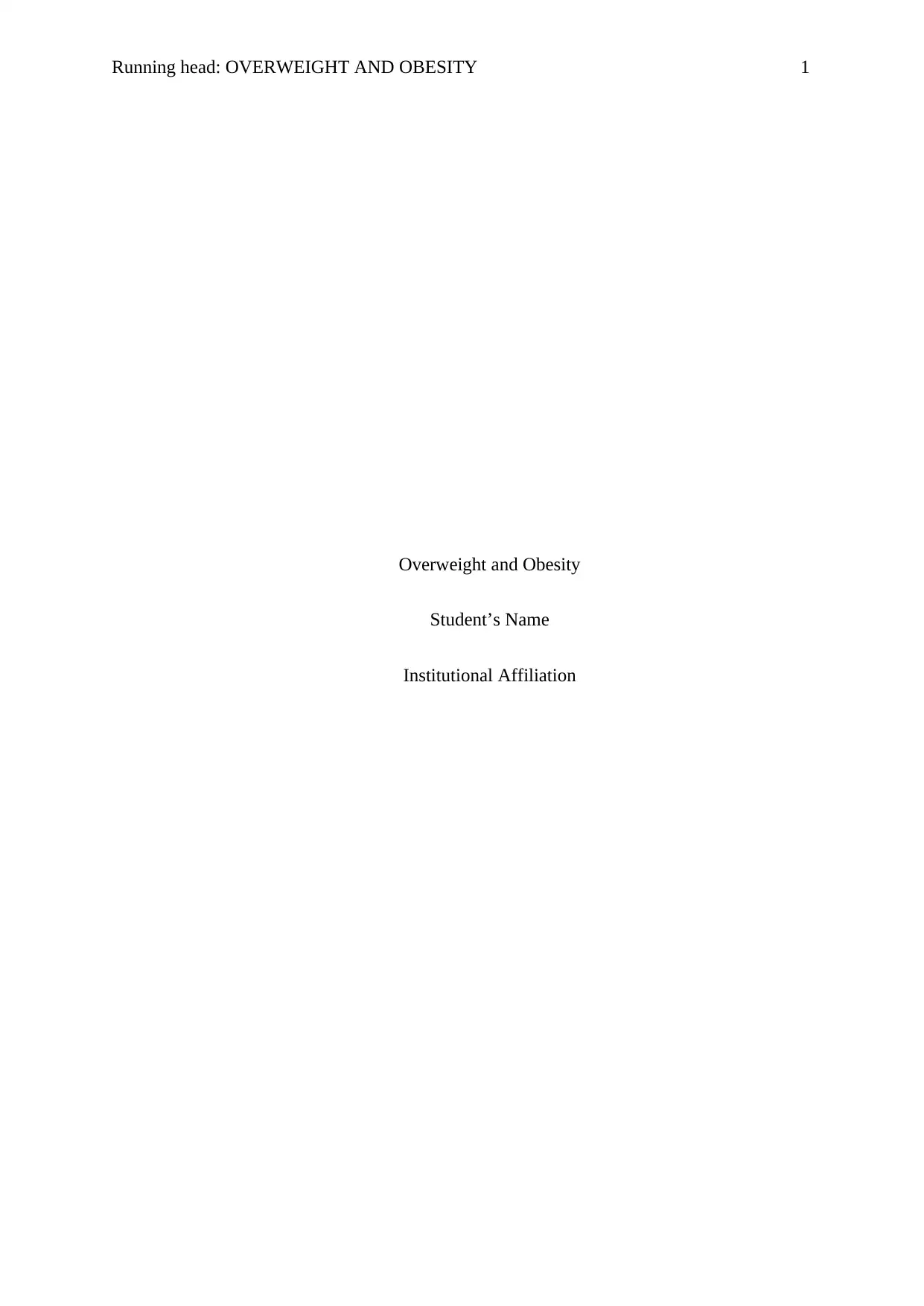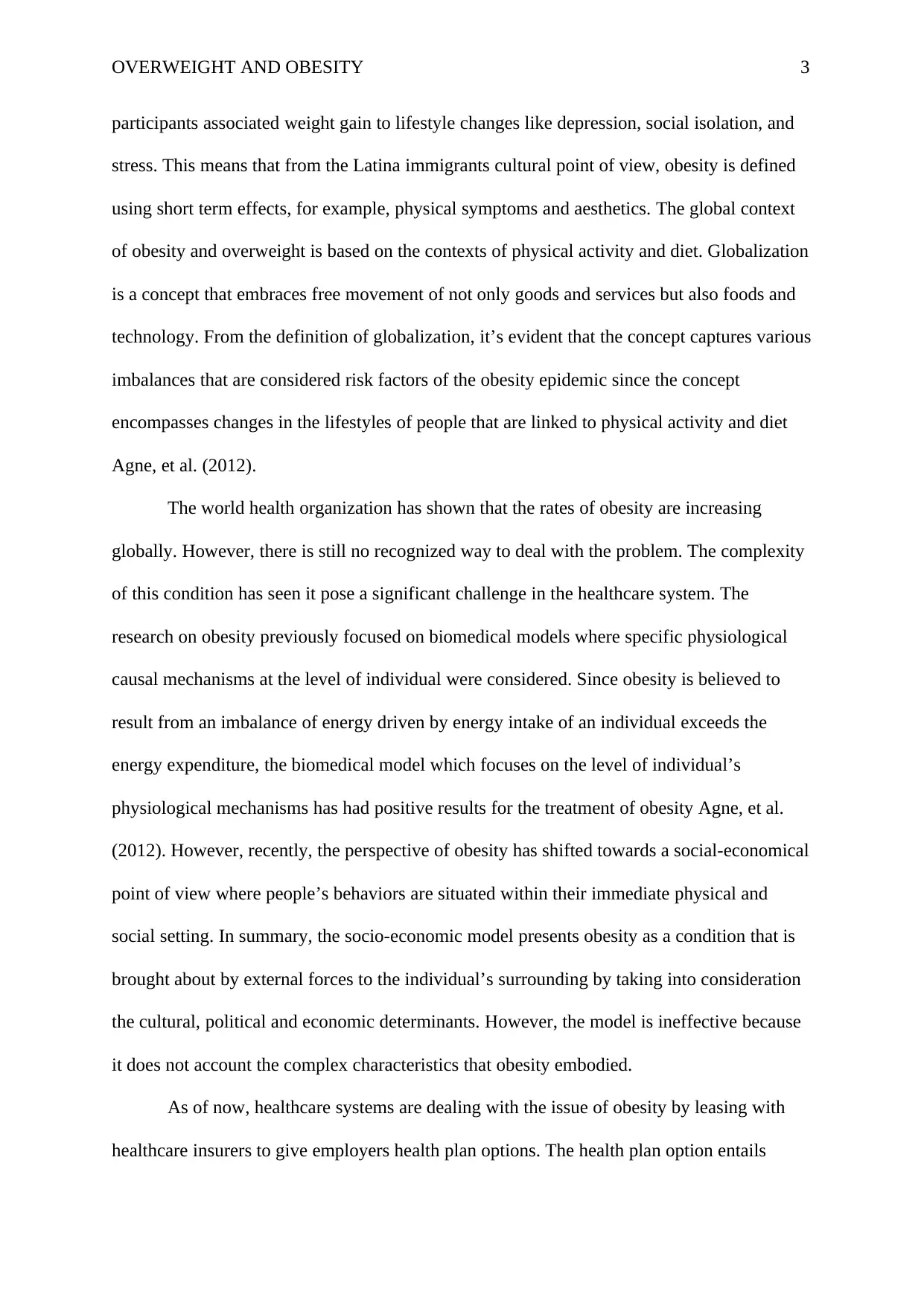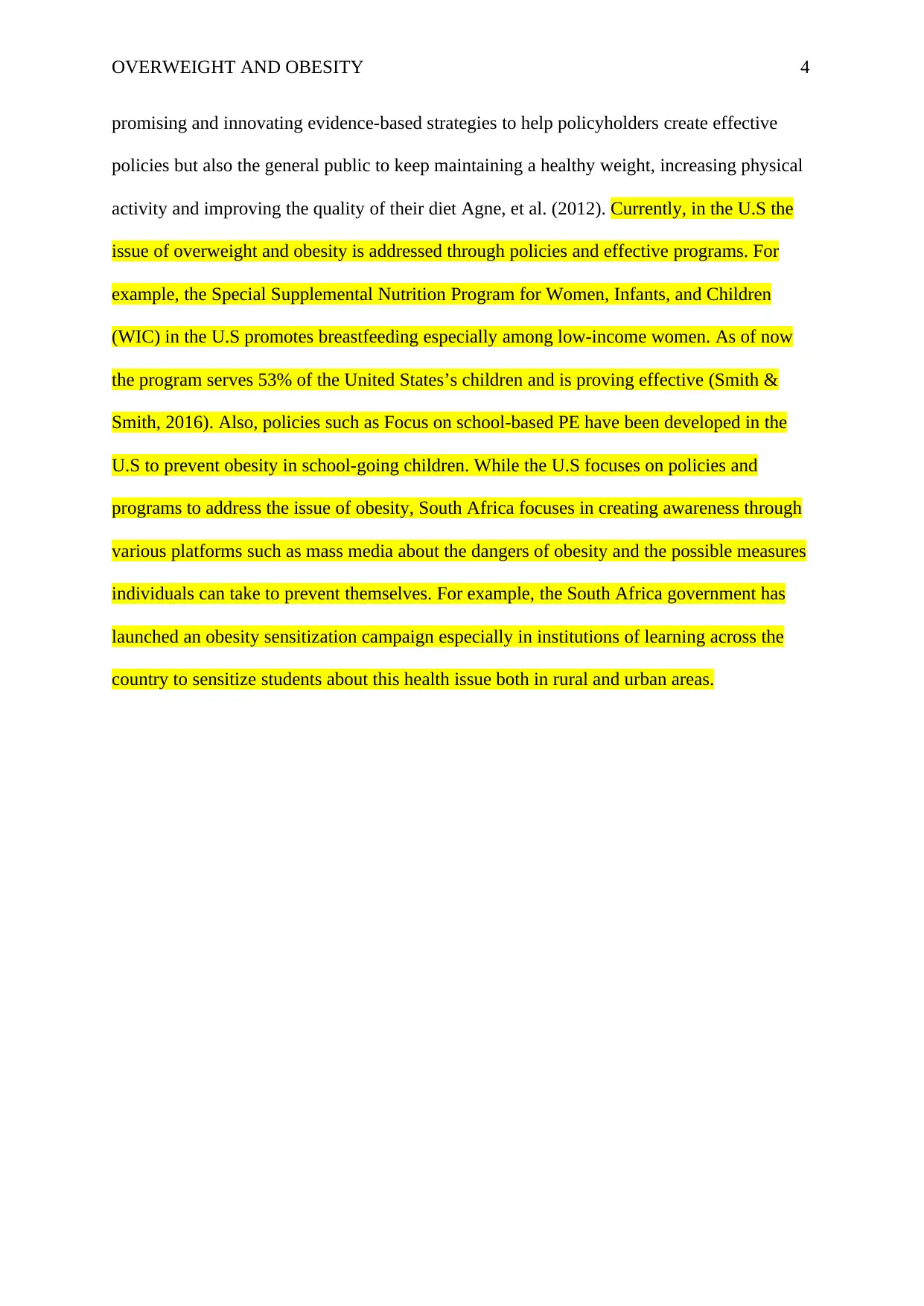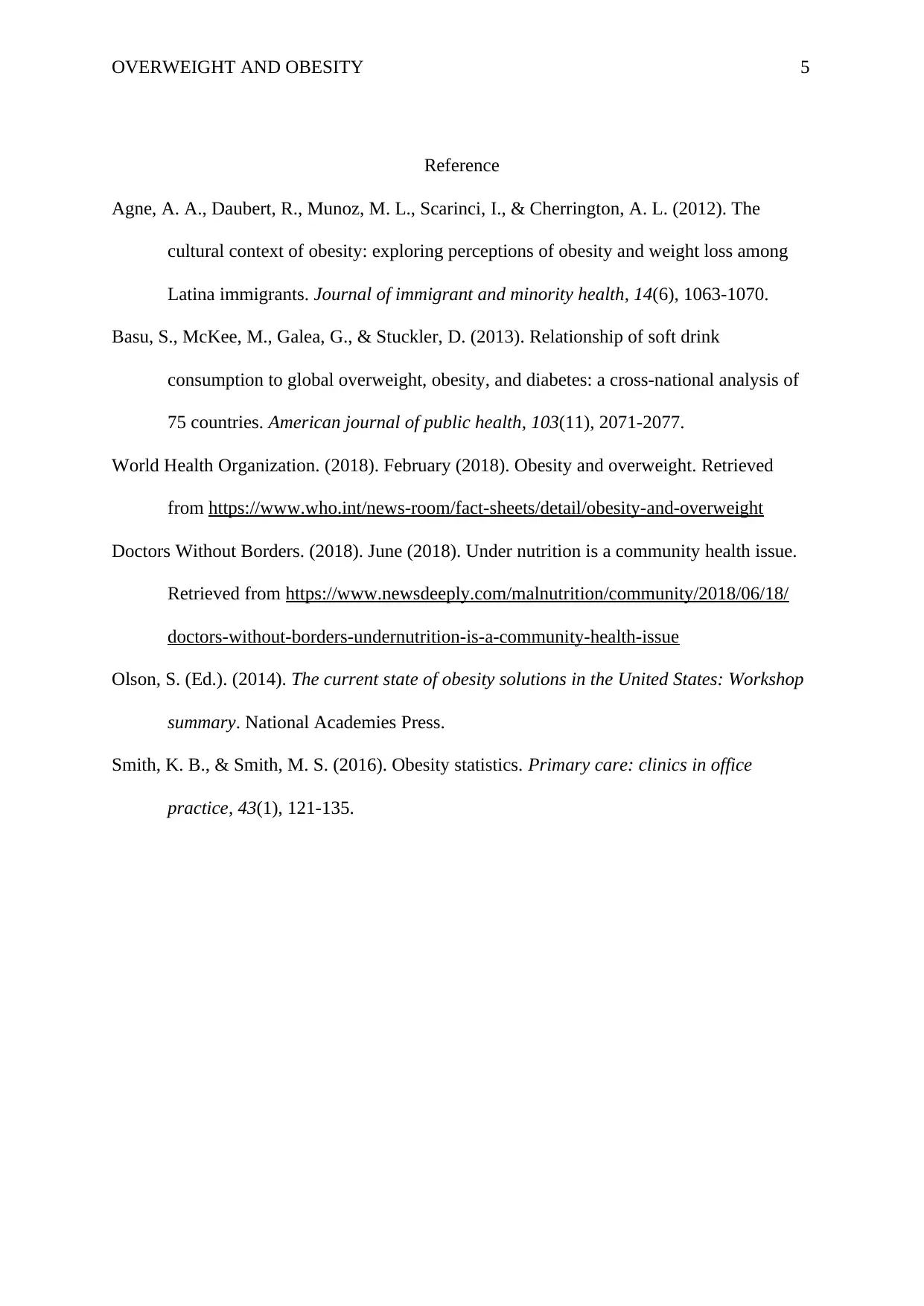Overweight and Obesity: Global Health Policies and Programs
VerifiedAdded on 2022/10/19
|5
|1228
|151
Essay
AI Summary
This essay delves into the pervasive global health issue of overweight and obesity, defining the terms and outlining their prevalence, which has tripled since 1975. It presents statistical data, highlighting the rising rates in both high and low-middle income countries and the increasing number of affected children. The essay explores various perspectives, including cultural contexts and the influence of globalization on physical activity and diet. It examines the shift from biomedical to socio-economic models in understanding obesity, and reviews current healthcare approaches, policies, and programs, such as those in the US and South Africa. The essay references key studies and reports from organizations like the World Health Organization to support its analysis.

Running head: OVERWEIGHT AND OBESITY 1
Overweight and Obesity
Student’s Name
Institutional Affiliation
Overweight and Obesity
Student’s Name
Institutional Affiliation
Paraphrase This Document
Need a fresh take? Get an instant paraphrase of this document with our AI Paraphraser

OVERWEIGHT AND OBESITY 2
Overweight and Obesity
Overweight and obesity is one of the main health problems that affect many people
around the world. In summary, overweight and obesity are terms used to explain the
bodyweight that is not healthy for a certain height (Basu et al., 2013). Extra body fat is the
main cause of overweight while extra muscle and bone result in overweight. A person is said
to be overweight when the BMI of that person ranges between 25 and 29-9 while a person
with a BMI over 30 is considered obese (Olson, 2014). Between 1975 and 2016, the
prevalence of obesity is said to have tripled. In 2016 alone, 13% (603million adults) of the
world’s adult population was obese with 40% of them being men and 15% women (Olson,
2014).
The world health organization reports that the prevalence of people who are either
obese or overweight is on the rise globally. For example, the number of children under the
age of five years that were either obese or overweight was 41 million in 2016 (World Health
Organization, 2018). Also, 2 billion adults which represent 39% of all adult population
globally were either obese or overweight obese (World Health Organization, 2018).
Previously, overweight and obesity was considered a high-income country problem.
However, the current statistics have shown that overweight and obesity is on the rise in both
low and middle-income countries. For example, since 2000, the number of under-five with
obesity has increased by 50%. Also, it’s believed that in 2016, half of either overweight or
obese under-five children lived in Asia (Doctors Without Borders, 2018). As of January
2019, the world health organization ranks American Samoa as the leading country with obese
people in the world. This is so because 74.6 of the American Samoa population is considered
obese (Doctors Without Borders, 2018).
A study conducted by Agne, et al. (2012) to determine the cultural context of obesity
by exploring obesity and weight loss perceptions among the Latina immigrants, most of the
Overweight and Obesity
Overweight and obesity is one of the main health problems that affect many people
around the world. In summary, overweight and obesity are terms used to explain the
bodyweight that is not healthy for a certain height (Basu et al., 2013). Extra body fat is the
main cause of overweight while extra muscle and bone result in overweight. A person is said
to be overweight when the BMI of that person ranges between 25 and 29-9 while a person
with a BMI over 30 is considered obese (Olson, 2014). Between 1975 and 2016, the
prevalence of obesity is said to have tripled. In 2016 alone, 13% (603million adults) of the
world’s adult population was obese with 40% of them being men and 15% women (Olson,
2014).
The world health organization reports that the prevalence of people who are either
obese or overweight is on the rise globally. For example, the number of children under the
age of five years that were either obese or overweight was 41 million in 2016 (World Health
Organization, 2018). Also, 2 billion adults which represent 39% of all adult population
globally were either obese or overweight obese (World Health Organization, 2018).
Previously, overweight and obesity was considered a high-income country problem.
However, the current statistics have shown that overweight and obesity is on the rise in both
low and middle-income countries. For example, since 2000, the number of under-five with
obesity has increased by 50%. Also, it’s believed that in 2016, half of either overweight or
obese under-five children lived in Asia (Doctors Without Borders, 2018). As of January
2019, the world health organization ranks American Samoa as the leading country with obese
people in the world. This is so because 74.6 of the American Samoa population is considered
obese (Doctors Without Borders, 2018).
A study conducted by Agne, et al. (2012) to determine the cultural context of obesity
by exploring obesity and weight loss perceptions among the Latina immigrants, most of the

OVERWEIGHT AND OBESITY 3
participants associated weight gain to lifestyle changes like depression, social isolation, and
stress. This means that from the Latina immigrants cultural point of view, obesity is defined
using short term effects, for example, physical symptoms and aesthetics. The global context
of obesity and overweight is based on the contexts of physical activity and diet. Globalization
is a concept that embraces free movement of not only goods and services but also foods and
technology. From the definition of globalization, it’s evident that the concept captures various
imbalances that are considered risk factors of the obesity epidemic since the concept
encompasses changes in the lifestyles of people that are linked to physical activity and diet
Agne, et al. (2012).
The world health organization has shown that the rates of obesity are increasing
globally. However, there is still no recognized way to deal with the problem. The complexity
of this condition has seen it pose a significant challenge in the healthcare system. The
research on obesity previously focused on biomedical models where specific physiological
causal mechanisms at the level of individual were considered. Since obesity is believed to
result from an imbalance of energy driven by energy intake of an individual exceeds the
energy expenditure, the biomedical model which focuses on the level of individual’s
physiological mechanisms has had positive results for the treatment of obesity Agne, et al.
(2012). However, recently, the perspective of obesity has shifted towards a social-economical
point of view where people’s behaviors are situated within their immediate physical and
social setting. In summary, the socio-economic model presents obesity as a condition that is
brought about by external forces to the individual’s surrounding by taking into consideration
the cultural, political and economic determinants. However, the model is ineffective because
it does not account the complex characteristics that obesity embodied.
As of now, healthcare systems are dealing with the issue of obesity by leasing with
healthcare insurers to give employers health plan options. The health plan option entails
participants associated weight gain to lifestyle changes like depression, social isolation, and
stress. This means that from the Latina immigrants cultural point of view, obesity is defined
using short term effects, for example, physical symptoms and aesthetics. The global context
of obesity and overweight is based on the contexts of physical activity and diet. Globalization
is a concept that embraces free movement of not only goods and services but also foods and
technology. From the definition of globalization, it’s evident that the concept captures various
imbalances that are considered risk factors of the obesity epidemic since the concept
encompasses changes in the lifestyles of people that are linked to physical activity and diet
Agne, et al. (2012).
The world health organization has shown that the rates of obesity are increasing
globally. However, there is still no recognized way to deal with the problem. The complexity
of this condition has seen it pose a significant challenge in the healthcare system. The
research on obesity previously focused on biomedical models where specific physiological
causal mechanisms at the level of individual were considered. Since obesity is believed to
result from an imbalance of energy driven by energy intake of an individual exceeds the
energy expenditure, the biomedical model which focuses on the level of individual’s
physiological mechanisms has had positive results for the treatment of obesity Agne, et al.
(2012). However, recently, the perspective of obesity has shifted towards a social-economical
point of view where people’s behaviors are situated within their immediate physical and
social setting. In summary, the socio-economic model presents obesity as a condition that is
brought about by external forces to the individual’s surrounding by taking into consideration
the cultural, political and economic determinants. However, the model is ineffective because
it does not account the complex characteristics that obesity embodied.
As of now, healthcare systems are dealing with the issue of obesity by leasing with
healthcare insurers to give employers health plan options. The health plan option entails
⊘ This is a preview!⊘
Do you want full access?
Subscribe today to unlock all pages.

Trusted by 1+ million students worldwide

OVERWEIGHT AND OBESITY 4
promising and innovating evidence-based strategies to help policyholders create effective
policies but also the general public to keep maintaining a healthy weight, increasing physical
activity and improving the quality of their diet Agne, et al. (2012). Currently, in the U.S the
issue of overweight and obesity is addressed through policies and effective programs. For
example, the Special Supplemental Nutrition Program for Women, Infants, and Children
(WIC) in the U.S promotes breastfeeding especially among low-income women. As of now
the program serves 53% of the United States’s children and is proving effective (Smith &
Smith, 2016). Also, policies such as Focus on school-based PE have been developed in the
U.S to prevent obesity in school-going children. While the U.S focuses on policies and
programs to address the issue of obesity, South Africa focuses in creating awareness through
various platforms such as mass media about the dangers of obesity and the possible measures
individuals can take to prevent themselves. For example, the South Africa government has
launched an obesity sensitization campaign especially in institutions of learning across the
country to sensitize students about this health issue both in rural and urban areas.
promising and innovating evidence-based strategies to help policyholders create effective
policies but also the general public to keep maintaining a healthy weight, increasing physical
activity and improving the quality of their diet Agne, et al. (2012). Currently, in the U.S the
issue of overweight and obesity is addressed through policies and effective programs. For
example, the Special Supplemental Nutrition Program for Women, Infants, and Children
(WIC) in the U.S promotes breastfeeding especially among low-income women. As of now
the program serves 53% of the United States’s children and is proving effective (Smith &
Smith, 2016). Also, policies such as Focus on school-based PE have been developed in the
U.S to prevent obesity in school-going children. While the U.S focuses on policies and
programs to address the issue of obesity, South Africa focuses in creating awareness through
various platforms such as mass media about the dangers of obesity and the possible measures
individuals can take to prevent themselves. For example, the South Africa government has
launched an obesity sensitization campaign especially in institutions of learning across the
country to sensitize students about this health issue both in rural and urban areas.
Paraphrase This Document
Need a fresh take? Get an instant paraphrase of this document with our AI Paraphraser

OVERWEIGHT AND OBESITY 5
Reference
Agne, A. A., Daubert, R., Munoz, M. L., Scarinci, I., & Cherrington, A. L. (2012). The
cultural context of obesity: exploring perceptions of obesity and weight loss among
Latina immigrants. Journal of immigrant and minority health, 14(6), 1063-1070.
Basu, S., McKee, M., Galea, G., & Stuckler, D. (2013). Relationship of soft drink
consumption to global overweight, obesity, and diabetes: a cross-national analysis of
75 countries. American journal of public health, 103(11), 2071-2077.
World Health Organization. (2018). February (2018). Obesity and overweight. Retrieved
from https://www.who.int/news-room/fact-sheets/detail/obesity-and-overweight
Doctors Without Borders. (2018). June (2018). Under nutrition is a community health issue.
Retrieved from https://www.newsdeeply.com/malnutrition/community/2018/06/18/
doctors-without-borders-undernutrition-is-a-community-health-issue
Olson, S. (Ed.). (2014). The current state of obesity solutions in the United States: Workshop
summary. National Academies Press.
Smith, K. B., & Smith, M. S. (2016). Obesity statistics. Primary care: clinics in office
practice, 43(1), 121-135.
Reference
Agne, A. A., Daubert, R., Munoz, M. L., Scarinci, I., & Cherrington, A. L. (2012). The
cultural context of obesity: exploring perceptions of obesity and weight loss among
Latina immigrants. Journal of immigrant and minority health, 14(6), 1063-1070.
Basu, S., McKee, M., Galea, G., & Stuckler, D. (2013). Relationship of soft drink
consumption to global overweight, obesity, and diabetes: a cross-national analysis of
75 countries. American journal of public health, 103(11), 2071-2077.
World Health Organization. (2018). February (2018). Obesity and overweight. Retrieved
from https://www.who.int/news-room/fact-sheets/detail/obesity-and-overweight
Doctors Without Borders. (2018). June (2018). Under nutrition is a community health issue.
Retrieved from https://www.newsdeeply.com/malnutrition/community/2018/06/18/
doctors-without-borders-undernutrition-is-a-community-health-issue
Olson, S. (Ed.). (2014). The current state of obesity solutions in the United States: Workshop
summary. National Academies Press.
Smith, K. B., & Smith, M. S. (2016). Obesity statistics. Primary care: clinics in office
practice, 43(1), 121-135.
1 out of 5
Related Documents
Your All-in-One AI-Powered Toolkit for Academic Success.
+13062052269
info@desklib.com
Available 24*7 on WhatsApp / Email
![[object Object]](/_next/static/media/star-bottom.7253800d.svg)
Unlock your academic potential
Copyright © 2020–2025 A2Z Services. All Rights Reserved. Developed and managed by ZUCOL.




